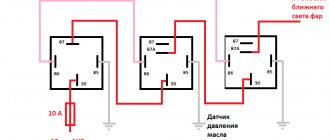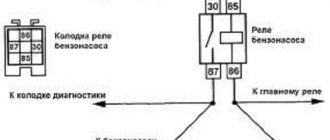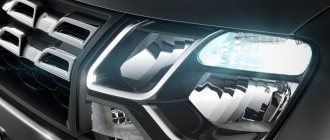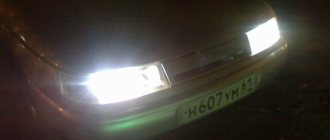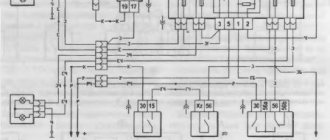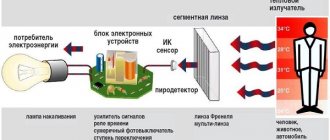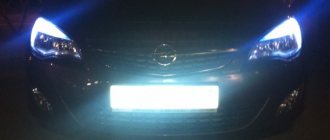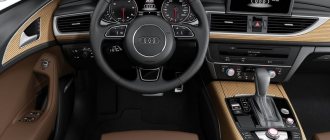No comments
Rating:
The quality of your view of the road while driving in the dark largely depends on which lamps are installed in the car headlight. Today, several types of lamps are installed - halogen, xenon and LEDs in car headlights. Each of them has its own advantages and disadvantages, but there is reason to believe that the LED is the most promising, and it is the future.
Today, many automobile companies produce cars with standard LED lights. Owners of cars where such bulbs are not provided in the standard optics, however, often replace them themselves in order to take advantage of the advantages of LEDs.
See also:
Which LEDs are best for cars?
Advantages of LED optics
Installation of diode light devices is allowed not only in low beam headlights, but also in high beam ones. A LED strip can be an excellent option for tuning the interior, and if you have an SUV, the LED beam can be installed on the roof.
First, we suggest that you familiarize yourself with the advantages that LED lighting sources have:
- Improved visibility, and we are talking not only about the road, but also about the side of the road, which is achieved through the use of several dozen diode elements. LED bulbs provide 45% more coverage to the sides of the vehicle. The coverage angle in this case is a parameter that depends on the specific headlights installed in the car.
- If the car's headlights are adjusted incorrectly, the right lamp will not be able to provide high-quality illumination of the space on the road. The fact is that the light from it will rest on the asphalt, which will not allow it to blind the driver of a car coming towards you. In the case of diode lighting elements, such disadvantages are not observed.
- One of the key advantages of diode light sources is selectivity. With proper adjustment, each LED element will be able to efficiently illuminate a certain section of the road surface in front of the car. That is, managing optics, which are divided into different sectors, will be simpler. If you use gas-discharge light bulbs (xenon), then in this case you can also achieve this advantage, but then you will need to use servos.
- One of the main advantages is their long service life, especially when comparing LEDs with incandescent or halogen lamps. The minimum service life of LED lamps today is about one hundred thousand hours, but much depends on the specific manufacturer.
- To provide high-quality lighting, LEDs will require significantly less power than halogen or xenon. Accordingly, the load on the on-board network will generally be lower.
- Another advantage is that LEDs are more resistant to vibrations than halogen and xenon lamps, as well as incandescent lamps. They are also not afraid of breakdowns in the suspension. These advantages also affect service life.
- Big choice. LEDs can be found in almost any automotive store, and the choice of such devices is really large. The consumer can purchase diode light sources taking into account his preferences and financial capabilities. Companies involved in the production of diode lamps today produce products that have different glow colors and different ranges. This refers to both lamps for low and high beams, as well as rear lights (the author of the video is the Scvo channel).
Making LED headlights with your own hands
Purchasing LED optics for a car will not be much of a problem. The automotive goods market presents a wide range of models to suit every taste and budget. However, such headlights are also made by hand.
You can make not only LED low beam headlights, but also fog lights, turn signals, side lights and taillights.
View gallery
To work you will need:
- LEDs and resistors (size and color at the discretion of the driver).
- Insulating tape.
- Soldering iron.
- Sealant.
- Drill for metal.
- Wire, marker, paint.
Operating principle of the LED optics control system
Diode lamps operate under the control of a control system; its operating principle is not particularly complicated.
Let us briefly consider the operating principle of such a system:
- If a car uses adaptive optics, it will be able to automatically adjust the lighting flow in accordance with the speed of the vehicle. If the car is also equipped with surveillance cameras in the front and rear, then with the correct settings it will be possible to adjust the lighting flow. This will prevent possible blinding of oncoming drivers.
- The system can be supplemented with a control module. This device is designed to automatically detect the oncoming flow of light and adjust the lighting flow of the headlights. The setting is made by turning off certain sections that can cause inconvenience to drivers of cars traveling towards them (video published by the Corcoran AL channel).
Is it allowed to install LED headlights with additional light?
Fans of off-road driving, hunters and fishermen use LED beams (or chandeliers) to additionally illuminate the space around the car. These devices consist of one or more LED assemblies and can be equipped with adjustment lenses. These devices have several varieties:
- FLOOD – for illuminating the nearby space;
- SPOT – acts as an LED high beam headlight;
- COMBINATION – a combination of the two previous options;
- WORKLIGHT – short-range work lighting with wide coverage of roadsides.
The disadvantage of LED devices of this type is the absence of a cut-off line: the headlight light has no vertical restrictions. Therefore, LED beams cannot be used when traveling on public roads.
- Google+
- LJ
- Blogger
How does LED optics work?
If you are planning to install diode devices in your car, we also suggest that you familiarize yourself with the operation of these lamps, in particular, we are talking about operating modes.
There may be several operating modes, in which case it all depends on the specific manufacturer and type:
- urban mode;
- rain or bad weather conditions;
- all-weather;
- high speed;
- Also, some optical units support operation in the mode of crossing complex intersections.
Thanks to the use of the control module, the driver does not need to independently change the lighting angle. To change the mode, you just need to turn off the desired LED sectors, which can blind other motorists. But you don’t need to rely on just one control module, which in fact may also not function correctly, this problem is especially relevant for cheap lamps. So, when purchasing, we recommend not to give preference to frankly cheap and low-quality devices, because the safety of the driver and passengers of the car depends on their performance.
Less powerful LED lamps can operate without a control module. These bulbs operate on the same principle as conventional bulbs. The driver turns on the optics with a switch in the car's interior, the generator supplies voltage to the headlights, as a result of which the latter begin to burn (video author - AssistanceTV).
Characteristics of DRL headlights
Instead of daytime running lights, the driver can use DRL headlights; this development was invented by European specialists. In this case, the reflector uses a 12-watt halogen light source, very similar to an an-distance light. When installing such optics, the light flux will be directed not at the road surface, as with low beam lighting, but into the eyes of other motorists. But at the same time, it will not blind drivers, but will provide better visibility of the car on the road. If you are interested in this method, this function can be implemented using high beams, while the headlights will shine not at half, but only at a third of the power.
Principle of operation
How does high beam work at full intensity? When the driver turns on the high beams, the optics will glow rather dimly, but this is enough to identify their vehicle on the road. At the same time, the light will not blind other road users. Of course, for this you need to install a separate button. When this button is turned off, the optics will switch to high beam mode. It should be noted that this will not in any way affect the implementation of all long-range lighting functions (the author of the video is Vitaly Sussky).
Advantages and disadvantages
If you decide to use high beams at full intensity instead of DRLs, then if you implement the task correctly, you will be able to experience the following advantages:
- Firstly, you don’t have to buy LED optics separately and waste time installing them. Accordingly, if you don’t understand anything about electrics, you also save yourself from having to spend money on installing headlights.
- Secondly, with the correct implementation of the circuit, you can ensure that the load on the battery will be lower. Accordingly, the likelihood that an older battery will discharge faster is minimized. This advantage is especially important for car enthusiasts who use dead batteries in the cold season, when they discharge even faster.
- Thirdly, the service life of low-beam lighting sources becomes longer. So you save yourself from more frequent financial costs for purchasing lamps.
- In addition, when implementing a DRL system, the luminous flux will shine a little higher, accordingly, the vehicle will be more noticeable in the flow of cars.
- When this feature is enabled, the tail lights will not illuminate, so they will not be able to “mask” the brake lights. This not only improves driving safety, but also allows you to increase the service life of the rear lamps.
- Also, you will not encounter the problem of dimming the interior lighting. When the side lights are on and the sun is bright outside, it will be more difficult for the driver to see the radio screen.
- Some car enthusiasts note that with the right approach, you can even achieve a reduction in fuel consumption. This figure is small, only about 0.15 liters per hour. However, this benefit can only be achieved if the engine is running correctly and fuel consumption is not increased beyond normal.
As for the shortcomings, in principle, there are none. The only disadvantages include the installation and implementation of the scheme, which can cause difficulties. But this problem can also be solved by carefully reading the instructions or contacting specialists.
Photo gallery “Schemes for ensuring the operation of high beams at full intensity”
Replacing a regular lamp with an LED one
How to install LED car headlight bulbs with your own hands? The replacement procedure may differ depending on the design features of the car's headlights.
Below you can find universal installation instructions using headlights with H4 bulbs as an example:
- First turn off the ignition and open the hood, and then disconnect the terminals from the battery.
- Remove the front right or left lamp cover that blocks access to the light source.
- Having done this, you will be able to see the back of the light bulb, to which the connector with wires is connected. This plug will need to be disconnected. After this, the installed lighting source can be dismantled.
- Next, you will need an LED light bulb. Remove the reflector cartridge. Using a flat-head screwdriver, you need to remove the factory reflector from the lamp. If possible, remove the socket from the installation side of the light bulb itself.
- After this, you will need to install the cartridge with the reflective element in the installation location for the light source. Securely fix the cartridge, as otherwise it will be subject to large vibrations, which can negatively affect the operation of the optics as a whole. If the design of the headlight does not allow it, the reflective element can be removed during installation. Make sure that the cartridge is securely fixed and installed without distortions, since the quality of lighting also depends on this. If the cartridge is not secured securely, the diode will quickly fail and the device will need to be repaired.
- Once these steps are completed, you will need to install a new light bulb in the socket. When installing, the lamp is rotated clockwise by the housing.
- Now you will need to make a hole in the cover that blocks access to the light source. The diameter of the hole should be about 2 cm, no more - this hole will be required to cool the radiator device of the lamp, as well as to transfer the power driver outside the flashlight.
- Then install the cover that will cover the light bulb. Install the light source so that the power plug, as well as the driver itself, are located outside.
- Now all you have to do is connect the standard plug to the device’s power plug, and then securely fix the power driver. For fixation, you can use glue or double-sided tape. The surface on which you will glue must be cleaned and degreased for better adherence of the tape.
Photo gallery “Light bulbs from different manufacturers”
Price issue
The cheapest set of LED light bulbs with an H4 base costs about one thousand rubles. Mid-price diodes will cost about 3-5 thousand rubles per set. As for more expensive options, their cost will be from 5 thousand rubles and more.
Connection via a 4-pin relay from a generator or oil sensor
The following two methods have a common basis and imply the operation of daytime running lights only after the engine is started. The circuit for switching on DRL from the generator is based on switching a four-contact relay and a reed switch.
The DRL relay contacts are connected as follows:
- 30 – to the positive terminals of LED modules;
- 85 – to the positive wire to the dimensions;
- 86 – to any reed switch output;
- 87 and the second terminal of the reed switch - to the “+” of the battery.
After checking the reliability of all contacts, proceed to setup. To do this, start the engine and, by moving the reed switch near the generator, achieve its activation and a stable glow of the DRL. Then the reed switch is hidden in a thermal tube and fixed in the found place using nylon ties.
At the moment of starting the engine, and then the generator, the contacts of the reed switch and relay close, supplying power to the LED running lights. In this case, the side lamps remain turned off, since the current through the relay coil is small to light them.
In the absence of a reed switch, you can power the DRL from the oil pressure sensor. In this case, pin 86 is connected to the oil pressure lamp. The rest of the circuitry is duplicated.
Both schemes have a common drawback. They cannot be used if LEDs are installed in the dimensions.
Read more: Daimler double six v12
